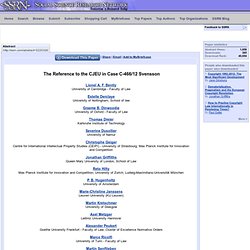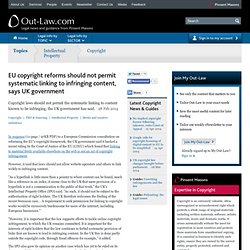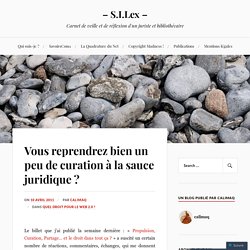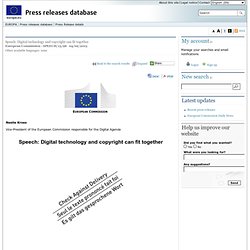

The Reference to the CJEU in Case C-466/12 Svensson by Lionel A. F. Bently, Estelle Derclaye, Graeme B. Dinwoodie, Thomas Dreier, Severine Dusollier, Christophe Geiger, Jonathan Griffiths, Reto Hilty, P. B. Hugenholtz, Marie-Christine Janssens, Martin Kre. Lionel A.

F. Bently University of Cambridge - Faculty of Law Estelle Derclaye University of Nottingham, School of law Graeme B. University of Oxford - Faculty of Law Thomas Dreier Karlsruhe Institute of Technology Severine Dusollier University of Namur Christophe Geiger Centre for International Intellectual Property Studies (CEIPI) - University of Strasbourg; Max Planck Institute for Innovation and Competition Jonathan Griffiths Queen Mary University of London, School of Law Reto Hilty Max Planck Institute for Innovation and Competition; University of Zurich; Ludwig-Maximilians-Universität München P.
University of Amsterdam Marie-Christine Janssens Leuven University (KU Leuven) Martin Kretschmer University of Glasgow Axel Metzger Leibniz University Hannover Alexander Peukert Goethe University Frankfurt - Faculty of Law; Cluster of Excellence Normative Orders Marco Ricolfi. EU copyright reforms should not permit systematic linking to infringing content, says UK government. In response (11-page / 97KB PDF) to a European Commission consultation on reforming the EU's copyright framework, the UK government said it backed a recent ruling by the Court of Justice of the EU (CJEU) which found that linking to material freely available elsewhere on the web is not an act of copyright infringement.

However, it said that laws should not allow website operators and others to link widely to infringing content. "As a hyperlink is little more than a pointer to where content can be found, much like a reference in an index, it seems clear to the UK that mere provision of a hyperlink is not a communication to the public of that work," the UK's Intellectual Property Office (IPO) said.
"As such, it should not be subject to the authorisation of right holders. The UK therefore welcomes the finding of the recent Svensson case... A requirement to seek permission for linking to copyright works would be excessively burdensome for users of the internet, including European businesses. "
Dutch Court of Appeal: hyperlinking is no copyright infringement. CJCE hyperlink is not communication to public. Propulsion, Curation, Partage… et le droit dans tout ça. Alors que Google vient d’annoncer le lancement de son bouton de partage +1, à l’image du fameux like de Facebook, la juriste Murielle Cahen publie sur le site Avocat Online une intéressante analyse, qui confronte ce type de fonctionnalités avec les principes du droit d’auteur à la française.

Son raisonnement, finement nuancé, tend à prouver que plusieurs principes du droit d’auteur, et notamment le droit moral, fragilisent ces pratiques de propulsion des contenus en direction des réseaux sociaux. Cela dit, il me semble que son analyse gagnerait à être complétée par la prise en compte du droit de courte citation, ainsi que d’une jurisprudence récente rendue à propos de l’exception de revue de presse. J’aimerais aussi, au delà de la question des boutons de partage et de la propulsion élargir la réflexion au domaine des nouveaux outils de curation des contenus, qui soulèvent à mon avis des questions encore plus épineuses de respect du droit d’auteur. Sur le même thème. Vous reprendrez bien un peu de curation à la sauce juridique.
Le billet que j’ai publié la semaine dernière : « Propulsion, Curation, Partage… et le droit dans tout ça ?

» a suscité un certain nombre de réactions, commentaires, échanges, qui me donnent envie de prolonger la réflexion, en creusant plusieurs points sur lesquels on a attiré mon attention. Décidément, vous allez voir que la curation est un sujet d’une grande richesse juridique, mais d’une grande complexité également… Pour assaisonner un peu vos pratiques de curation, je vous recommande la sauce juridique ! (Hot Sauce Bar. Par Josh Koonce. L’épineuse question du droit applicable. The IPKat and his blogging friends. PRESS RELEASES - Press Release - Speech: Digital technology and copyright can fit together. European Commission Neelie Kroes Vice-President of the European Commission responsible for the Digital Agenda Speech: Digital technology and copyright can fit together Stakeholders dialogue on copyright "Licences for Europe" 4 February 2013 New technologies have huge implications for the creative sector.

I was first confronted with this relationship as the Competition Commissioner at the time of the "CISAC decision". Because the fact is, old practices need to adapt to new digital realities. So in 2008 I set up the Roundtable on Online Music, which gave rise to the Global Repertoire Database, making information on copyrighted works more coherent and accessible. Looking back, I am happy to see the world changing and evolving. That to me is the wrong approach. The right approach is the other way round: we should rather adapt practices to fit new digital opportunities. And it's not just music embracing digital innovation. That can boost research, and potentially save lives. Is a clickable link a communication to the public? New case referred to the CJEU. Save our hyperlinks! Paws for reflection as Profs Opine.
European_Copyright_Society_Opinion_on_Svensson. InfoCuria. LexUriServ.